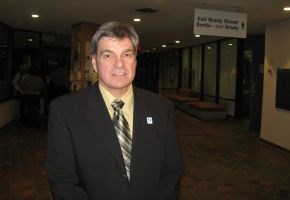Posted by Sudbury Northern Life Reporter Bill Bradley
Mayor John Rodriguez sounded the alarm about the proposed biosolids treatment facility being proposed to help deal with odour problems in the western part of the city. The potential $40 million cost was his top concern.
 For over 30 years, the city along with the Vale Inco Copper
Cliff wastewater plant, the Espanola wastewater plant and the
Blind River wastewater plant, have had a cheap method of
disposing sewage sludge, according to a report prepared for the
priorities committee of city council Wednesday.
For over 30 years, the city along with the Vale Inco Copper
Cliff wastewater plant, the Espanola wastewater plant and the
Blind River wastewater plant, have had a cheap method of
disposing sewage sludge, according to a report prepared for the
priorities committee of city council Wednesday.
Effluent is dumped into a Vale Inco tailings area near Lively. But flare ups of odour in 2005 and 2007 caused a rash of complaints from nearby residents. Short term measures such as liming were enacted to lessen the problem.
Recent developments demanded a long-term solution, said Nick Benkovich, Greater Sudbury director of water and wastewater services.
The city was put on notice by Vale Inco to relocate the the sludge disposal operation off their property by 2010, he noted. The favoured solution under investigation is a biosolids facility to be sited at the existing Kelly Lake wastewater treatment plant.
The plant would treat the sludge. Using new technology, it would turn it into a soil amendment product that could be used in the area re-greening projects or even in backyards if of high enough quality, said Benkovich.
Benkovich briefed the priorities committee on costs and time lines for the project, now estimated at $40 million.
The cost rattled Rodriguez.
"I recall some years back, the facility would cost $9 million. Now it is $40 million," said Rodriguez. "This is sounding like the Maley Drive Extension Project, where costs have dramatically escalated. How can you be sure it will not cost this city $60 million?" he asked.
"Nick, I want to be assured we get the best price for what is needed. We do not need a top-of-the-line facility that may be the fancy of the consultants," said Rodriguez.
"We as a council, will be watching you Nick," warned the mayor.
Benkovich outlined a number of ways of reducing costs.
Federal and provincial infrastructure funding could be sought. Greg Clausen, general manager of infrastructure services, said he expected the project could be eligible for federal Building Canada funding.
Ward 3 Coun. Claude Berthiaume asked if the city could partner with other users of the present tailings pond, the towns of Espanola and Blind River.
"We will explore that. They could be paying customers of the facility," noted Benkovich.
Another cost reduction measure is to partner with the private sector.
"Other cities have used this approach. The plant would produce a marketable product that can be sold," said Benkovich.
The advantage is that private money could substitute for some municipal funds and the private operator, if they built it, would have an extra incentive to ensure the construction of the plant was of the highest quality.
In addition, such private and public sector pairings, called P3s, seem to be in favour in Ottawa, according to local federal politicians. But both both Nickel Belt NDP MP Claude Gravelle and Sudbury NDP MP Glenn Thibeault said they oppose the P3 projects because of cost overruns and time delays in projects elsewhere.
"We have opposed P3s for years," said Gravelle recently.
Benkovich said he knew of P3 success stories.
"My understanding is that there are several facilities in Southern Ontario where these arrangements have worked well," he said. He also said the cost of the biosolids plant would be equal to his whole budget for two years.
"We need money to pay for scheduled and annual upgrades to the facilities we have now. We need to minimize the city's contribution."
Benkovich did admit a private public partnership was more complicated and could cause delays.
"Despite the advantages of the design/build/operate construction model, the additional preliminary planning and negotiation associated with the model is likely to involve extra lead time. City staff has made arrangements for approvals from Vale Inco to extend the project completion date if necessary to allow for a full examination of these complex financial issues," added Benkovich.
"I see red flags over P3s," warned Berthiaume.
"In the past when these kind of arrangements are made, the city gets stung with additional expenditures. The private sector may decide not to continue with it. Then the city has to pick up those costs as in Hamilton."
Berthiaume said it is always good to have access to more capital for any project. But caution needs to be exercised.
"What if the company goes bankrupt or the company decides to
sell the facility to another company. Maybe the next company
will not have the same standards as the first one."
The report was presented as an information item only to the
priorities committee. Council will continue to be briefed on
progress of the development and have discretionary powers over
how the project is to be financed, said Benkovich.
